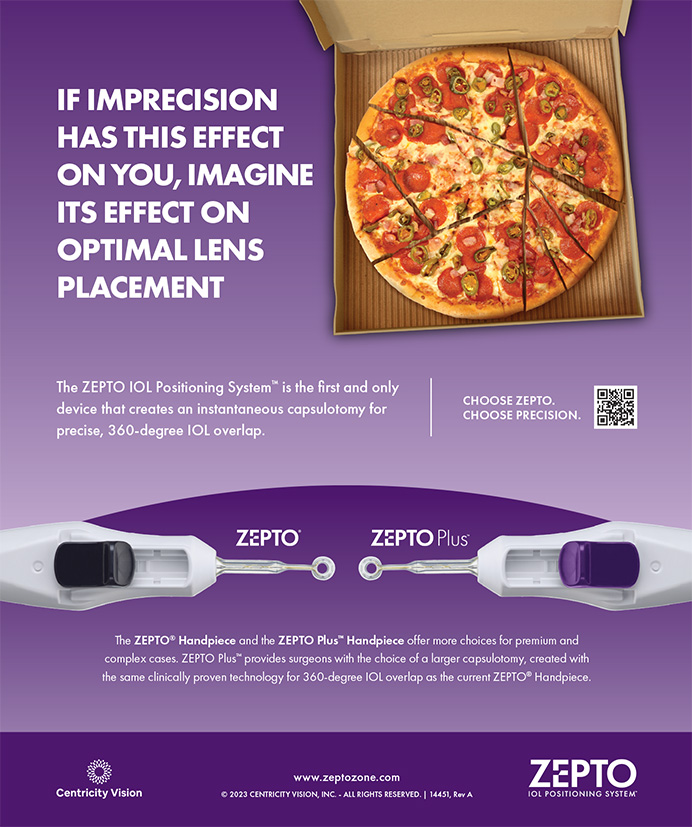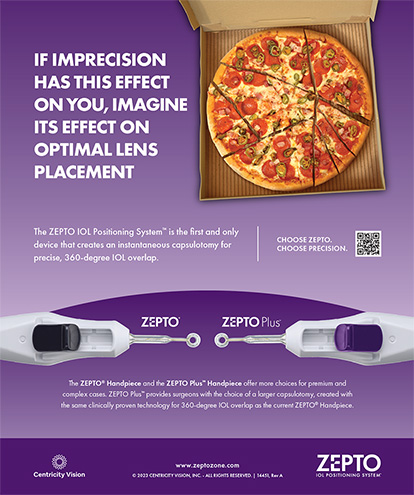In cataract surgery, the initial part of the learning curve is steep, which is why ophthalmic training programs provide close supervision in the OR. During the first 100 cataract cases, residents learn basic concepts under the active guidance of an experienced attending surgeon, a setup that helps to ensure patients’ safety.
The next challenge beginning surgeons face is developing more advanced skills in order to deliver a gentler, less traumatic, safer, and more efficient cataract procedure
THE INCISION’S CREATION
Creating a consistent corneal incision with stable architecture is among the most important steps of cataract surgery. A poorly constructed incision will induce more astigmatism, and it may leak during surgery and destabilize the anterior chamber. Moreover, a cataract incision that fails to seal properly puts the eye at higher risk of postoperative endophthalmitis.
Corneal incisions should have essentially square dimensions such that the length of the tunnel is about the same as the width of the incision (Figure 1). This architecture ensures a greater area of contact when the incision is closed. Most often, surgeons choose the temporal cornea for the incision, because it is farther from the center of the cornea compared with the other meridians. Incisions that are completely avascular may not heal as strongly as those that nick the limbal vessels. Although most corneal incisions are self-sealing, a suture occasionally may be required to ensure that they are watertight.
The corneal incision can be a one-, two-, or three-plane design, but it should be consistent. Having a reliable incision will allow the surgeon to determine the astigmatic flattening effect, known as the surgically induced astigmatism. By incorporating this information into the surgical plan, the ophthalmologist can improve postoperative refractive results and provide better vision to patients. Calculating one’s own surgically induced astigmatism requires recording the preoperative keratometry readings, locations of the incision, and postoperative keratometry readings for a cohort of at least a dozen patients. The data can be analyzed easily with simple vector math to determine the average effect of the incision.
CAPSULORHEXIS
The capsulorhexis is important to nuclear stability during phacoemulsification and to secure fixation of the IOL. Beginning cataract surgeons often have difficulty creating the capsulorhexis, primarily due to the challenges of pivoting within the incision without distorting it. Deformation of the incision leads to a loss of viscoelastic and a radialized capsular opening. These problems can be avoided through the use of a more retentive viscoelastic as well as by floating gently within the incision. If the surgeon begins to lose control of the capsulorhexis, he or she can rescue it with techniques such as the Little rescue.1,2
With most IOLs, the goal is to create a capsulorhexis that overlaps the edge of the optic for a full 360°. This ensures that the IOL will stay within the capsular bag and not prolapse forward, which could chafe the iris and result in a myopic surprise. Power calculations assume that the IOL will be contained within the capsular bag, resulting in a more predictable effective lens position and a more accurate postoperative refractive result.
Because the optics of most IOLs have a diameter of 6 mm, an appropriate goal for the capsulorhexis is a diameter of 5 mm, which will provide a 0.5-mm overlap. To measure this ideal diameter, the surgeon can mark the cornea. The result can be variable, however, due to variations in corneal curvature and anterior chamber depth. A more consistent approach is to perform intraocular measurements with a calibrated capsulorhexis forceps. This instrument has a mark that is 2.5 mm from the tip, representing the radius, and an additional mark 5 mm from the tip, representing the diameter (Figure 2). In the future, laser cataract surgery may augment the accuracy with which surgeons can create the capsulorhexis.
PHACO SETTINGS
The most challenging part of cataract surgery is removing the nucleus by means of phacoemulsification. Ultrasonic power is a double-edged sword: although surgeons need it to help emulsify and aspirate the lens nucleus, phaco power can also harm delicate ocular structures such as the corneal endothelium. As ophthalmologists develop more advanced phaco skills, they must learn to minimize the amount of ultrasonic energy placed in the eye and reduce the amount of saline that is flushed through the anterior segment.
Phaco power modulations are programmed settings that allow ultrasonic energy to be delivered as pulses or bursts. The phaco energy can be delivered in a longitudi- nal or torsional direction, and it can be programmed so that the higher levels of ultrasound are only applied when a nuclear cataract piece occludes the phaco tip. The surgeon’s goal is to use the least amount of phaco energy possible, not just by adjusting his or her settings, but also by mechanically disassembing the nucleus. There are a number of nucleofractis techniques, each designed to fragment the cataract into more manageable pieces. They include phaco chop, phaco prechop, and divide and conquer.
Phaco fluidic settings are designed to keep the anterior chamber stable and to aspirate cataract fragments. Balancing the inflow and the outflow is the first step in achieving excellent fluidics. The primary principle is Poiseuille’s equation, which simply states that the rate of fluid flow is proportional to the radius of the tubing to the power of 4. This means that a small decrease in the tubing’s size produces a large decrease in fluid flow. This equation becomes important as surgeons move toward microincisional cataract surgery with incisions of 2 mm or less. A useful analogy is that of a drinking straw. If the straw is large bore, then only a small amount of vacuum in the mouth is needed to draw up a large flow of fluid. If the straw is small bore, however, then a large amount of vacuum in the mouth is needed to aspirate a small amount of fluid.
CONCLUSION
Implementing three simple changes is the first step in moving from beginning to advanced cataract surgery. First, ophthalmologists should tailor their phaco power modulations and fluidic settings to match their style and technique of surgery. The goal is to keep the margin of safety high while being as efficient as possible. Second, they must improve their ability to make a consistently sized capsulorhexis. Third, surgeons must achieve pre- dictability in their construction of the cataract incision.
Uday Devgan, MD, FRCS, is in private prac- tice at Devgan Eye Surgery in Los Angeles. Dr. Devgan may be reached at (800) 337-1969; devgan@gmail.com.
- Little BC, Smith JH, Packer M. Little capsulorhexis tearout rescue. J Cataract Refract Surg. 2006;32(9):1420-1422.
- Little B. Retrieval maneuver for CCC tear-out. Cataract & Refractive Surgery Today. October 2007;7(10):70-72. http://www.bmctoday.net/crstoday/2007/10/article.asp?f=CRST1007_14.php. Accessed April 14,2011.


